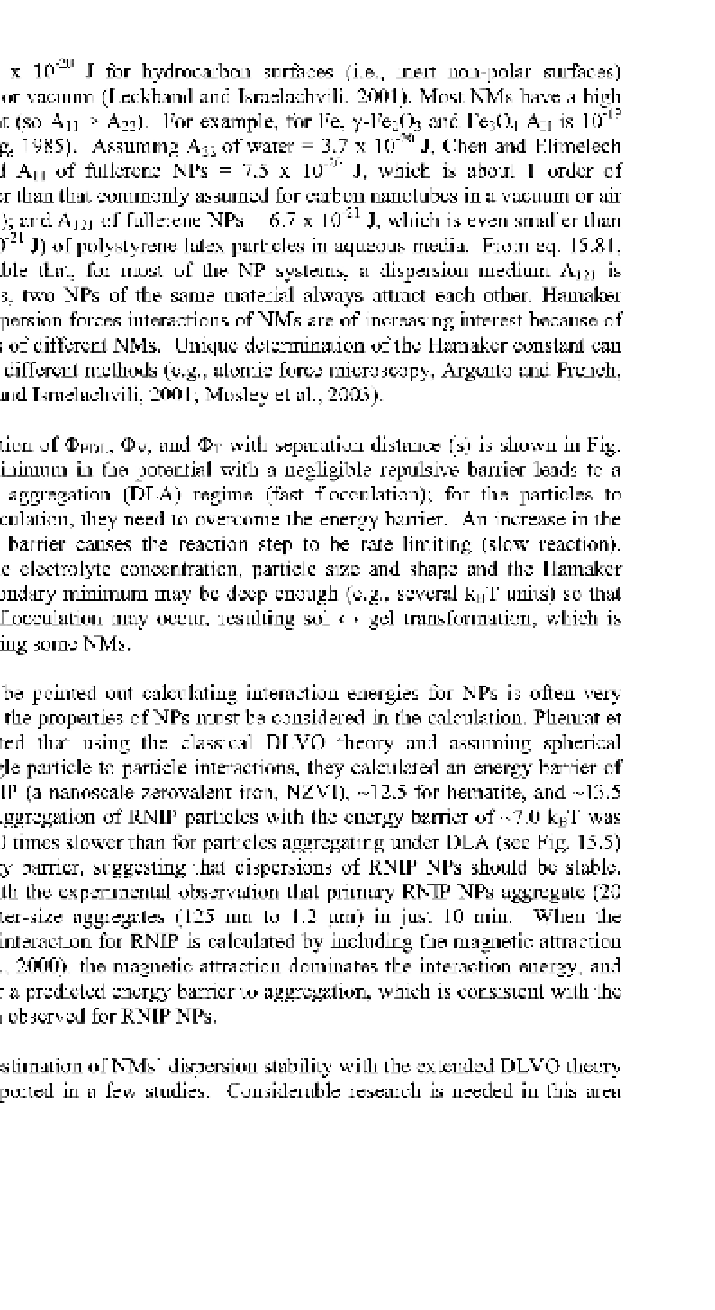Environmental Engineering Reference
In-Depth Information
solutions, and 5 x 10"
2
0
J for hydrocarbon surfaces (i.e., inert non-polar surfaces)
interacting in air or vacuum (Leckband and Israelachvili, 2001). Most NMs have a high
Hamaker constant (so AH > A22). For example, for Fe, y-Fe2O3 and FesCU AH is 10"
1
9
N'm (Rosensweig, 1985). Assuming A22 of water = 3.7 x 10"
2
0
J, Chen and Elimelech
(2006) calculated A
n
of fullerene NPs = 7.5 x 10"
2
0
J, which is about 1 order of
magnitude smaller than that commonly assumed for carbon nanotubes in a vacuum or air
(2.3-6.0 x 10"
1
9
J); and
A
m
of fullerene NPs = 6.7 x 10"
2
1
J, which is even smaller than
the Ai2i (9.5 x 10"
2
1
J) of polystyrene latex particles in aqueous media. From eq. 15.81,
it is understandable that, for most of the NP systems, a dispersion medium Ai2i is
positive and, thus, two NPs of the same material always attract each other. Hamaker
constants and dispersion forces interactions of NMs are of increasing interest because of
wide applications of different NMs. Unique determination of the Hamaker constant can
be achieved with different methods (e.g., atomic force microscopy, Argento and French,
1996; Leckband and Israelachvili, 2001; Mosley et al, 2003).
The variation of OEDL, ®v, and OT with separation distance (s) is shown in Fig.
15.5. A deep minimum in the potential with a negligible repulsive barrier leads to a
diffusion-limited aggregation (DLA) regime (fast flocculation); for the particles to
undergo fast flocculation, they need to overcome the energy barrier. An increase in the
repulsive energy barrier causes the reaction step to be rate limiting (slow reaction).
Depending on the electrolyte concentration, particle size and shape and the Hamaker
constant, the secondary minimum may be deep enough (e.g., several ksT units) so that
weak reversible flocculation may occur, resulting sol <-> gel transformation, which is
important in making some NMs.
It should be pointed out calculating interaction energies for NPs is often very
complicated, and the properties of NPs must be considered in the calculation. Phenrat et
al. (2007) reported that using the classical DLVO theory and assuming spherical
particles and single particle to particle interactions, they calculated an energy barrier of
~7.0 ksT for RNIP (a nanoscale zerovalent iron, NZVI), -12.5 for hematite, and -13.5
for magnetite. Aggregation of RNIP particles with the energy barrier of -7.0 ksT was
predicted to be 90 times slower than for particles aggregating under DLA (see Fig. 15.5)
without an energy barrier, suggesting that dispersions of RNIP NPs should be stable.
This contrasts with the experimental observation that primary RNIP NPs aggregate (20
nm) to micrometer-size aggregates (125 nm to 1.2 |im) in just 10 min. When the
potential energy interaction for RNIP is calculated by including the magnetic attraction
(de Vicente et al., 2000), the magnetic attraction dominates the interaction energy, and
there is no longer a predicted energy barrier to aggregation, which is consistent with the
rapid aggregation observed for RNIP NPs.
To date, estimation of NMs' dispersion stability with the extended DLVO theory
has only been reported in a few studies. Considerable research is needed in this area

Search WWH ::

Custom Search